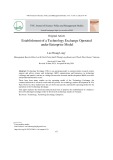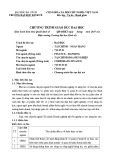
http://www.iaeme.com/IJM/index.asp 213 editor@iaeme.com
International Journal of Management (IJM)
Volume 8, Issue 3, May–June 2017, pp.213–219, Article ID: IJM_08_03_024
Available online at
http://www.iaeme.com/ijm/issues.asp?JType=IJM&VType=8&IType=3
Journal Impact Factor (2016): 8.1920 (Calculated by GISI) www.jifactor.com
ISSN Print: 0976-6502 and ISSN Online: 0976-6510
© IAEME Publication
A STUDY OF MUTUAL FUNDS
Reepu
USB, Chandigarh University, Gharuan, India
ABSTRACT
Three Boston executives in 1924 pooled their money with no idea of how popular
the assemblage would become. The formation of Unit Trust of India, 1963 along with
the inventiveness of Government of India and Reserve Bank, led to the dawn of new
industry i.e. mutual fund industry in India. Its huge corpus enables diversification,
thereby minimizing the risks and maximizing the returns. In order to become customer’s
preference now-a-days, numerous specialised plans in specific to retirement, children
etc have also been fabricated. The present paper is an attempt to know about Mutual
Fund, it’s various schemes and analyse the different risk factors involved.
Key words: Diversification, Mutual Fund, Return, Risk, Schemes etc.
Cite this Article: A Study of Mutual Funds, Reepu. International Journal of
Management, 8 (3), 2017, pp. 213–219.
http://www.iaeme.com/IJM/issues.asp?JType=IJM&VType=8&IType=3
1. INTRODUCTION
Mutual fund is an investment company that pools money from shareholders and invests in a
variety of securities, such as stocks, bonds and money market instruments. Most open-end
Mutual funds (also known as an open-end investment company, to differentiate it from a closed-
end investment company) continuously offer new shares to investors. Mutual funds invest
pooled cash of many investors to meet the fund's stated investment objective. Mutual funds
stand ready to sell and redeem their shares at any time at the fund's current net asset value i.e.
total fund assets divided by shares outstanding.

A Study of Mutual Funds
http://www.iaeme.com/IJM/index.asp 214 editor@iaeme.com
In other words, Mutual Funds coalesces different resources through the issuance of units to
investors and enables investment of pooled funds in varied securities in lieu of disclosed
objectives of offer documents. Security investments are spread across a wide cross-section
of industries and sectors and thus the risk is reduced. Diversification reduces the risk
because all stocks may not move in the same direction in the same proportion at the same
time. Different units are issued to the investors (who are also called as unit holders) by the
Mutual Funds as per the money invested by them and hence as per the investment, profits as
well as losses are shared amongst them. Now-a-days Mutual Funds offer different schemes with
diverse objectives. Before moving towards the market, the Mutual Fund has to be registered
with SEBI which scrutinizes it across different facets. Hence, Mutual Fund is an optimum
alternative where investors with comparable investment objectives could pool in the money,
Investment Manager therefore would invest money in accordance to the scheme objectives.
Characteristics:
• Investors purchase mutual fund shares from the fund itself (or through a broker for the fund)
instead of from other investors on a secondary market, such as the New York Stock Exchange
or Nasdaq Stock Market.
• The price that investors pay for mutual fund shares is the fund’s per share net asset value (NAV)
plus any shareholder fees that the fund imposes at the time of purchase (such as sales loads).
• Shares are redeemable.
• Usually Mutual Funds generate new shares in order to house fresh investors.
• Investment advisors tend to manage the portfolio’s of Mutual Funds.
2. REVIEW OF LITERATURE
Dr. Singh B K (2012) detailed about the mutual fund operation, NAV calculation and further
several demographic factors of investors towards their attitude of investment have also been
considered. Chi-square test has been deployed in order to gain conclusions. Dr. Vyas R. (2012)
prospected that although financial markets have turned to be expensive but different financial
instruments which are introduced, require unification. Author researched about factors affecting
investors for investing in mutual fund. Research highlighted that mostly investors choose bank
and post office deposits as one of the investment avenues, in comparison to Mutual Fund.
Equity and SIP are among the priority list. Prabhavathi Y. et al (2013) focussed on
understanding about the attitude, awareness and preferences of mutual fund investors. They
found that mostly SIPs have been preferred and moreover, Mutual Fund is a choice of several

Reepu
http://www.iaeme.com/IJM/index.asp 215 editor@iaeme.com
because of better returns as well as professional fund management. Solanki A. (2016) compared
the performance of selected Reliance equity schemes from the time period of 1
st
April 2007 to
31
st
March 2016 with BSE National 100 and SENSEX returns. The study concluded that the
selected schemes had higher returns than the Benchmark Index. But the study considered only
the open ended schemes with only growth options undertaken. Prof Prabhu G. et al (2016)
believed that Mutual Fund Industry in India is at rapid growth rate. It is considered that Mutual
Fund investments are less risky in comparison to investments in other securities. But it has been
inferred from the study that still several investors have not been aware about the benefits of
investing in Mutual Funds.
3. MUTUAL FUND STRUCTURE
Figure 2 Mutual Fund Structure
Different parties involved are:
• Sponsor: Sponsor is an entity who in arrangement with other corporate led towards the creation
of a Mutual Fund. He needs to comply with the criterion set under Securities and Exchange
Board of India (Mutual Funds) Regulations, 1996 and must have to throw in at least 40% of the
net worth. But the sponsor could never be held accountable for any type of loss as a consequence
of scheme operation.
• Trust: Sponsor forms Mutual Fund as a trust as per the provisions of Indian Trusts Act, 1882.
Deed is registered under the Indian Registration Act, 1908.

A Study of Mutual Funds
http://www.iaeme.com/IJM/index.asp 216 editor@iaeme.com
• Trustee: They are accountable to uphold the investor’s interests as well as ensure that AMC
works as per the guidelines of SEBI. Among the constituent members of the trustee, at least 2/3
are independent directors, since they do not relate to trustee in any form.
• Asset Management Company: AMC is appointed by the Trustee, which requires approval by
SEBI to operate as Asset Management Company of Mutual Fund. Such formation too involves
50% independent directors and net worth of at least 10 cr. all the time.
Registrar or Transfer Agent: AMC assigns Registrar in order to perform functionaries
related to application form, redemption requests etc.
4. DIFFERENT TYPES OF MUTUAL FUNDS
The different types of Mutual Funds can be diagrammatically represented as:
Figure 3 Mutual Fund Types

Reepu
http://www.iaeme.com/IJM/index.asp 217 editor@iaeme.com
5. INDICATORS OF INVESTMENT RISK
MEASURES DESCRIPTION IDEAL RANGE
STANDARD
DEVIATION
Standard Deviation evaluates fund’s volatility.
The standard deviation of a
Fund measures this risk by measuring the degree to which
the fund fluctuates in relation to its mean return.
Should be near to its mean
return.
BETA A common measure of risk is Beta. It signifies the
volatility of the fund in comparison to the benchmark.
Beta>1 = high risky
Beta = 1 = Avg
Beta<1 = Low Risky
R-SQUARE R-square connotes the correlation of a fund’s movement to
an index. It describes the relation between the fund's
volatility and market risk.
R-square values range
between 0 and 1, where 0re
presents no correlation
and1 represents full
correlation.
ALPHA Alpha is the difference between the returns one would expect
from a fund, given its beta and the
return it actually produces. It also measures the unsystematic
risk.
Alpha is positive
= returns of stock are
better than market
returns.
Alpha is negative
= returns of stock are
worst then market.
Alpha is zero = returns are
same as market.
SHARPE
RATIO
Sharpe Ratio= Fund return in excess of risk free return/
Standard deviation of Fund. Sharpe ratios are ideal for
comparing funds that have a mixed asset classes.
Higher Sharpe ratio
better funds returns
relative to amount of
risk taken.
6. RISKS ASSOCIATED WITH MUTUAL FUND
It is well said that Higher the Risk, Higher the Returns. Tolerance for risk varies from one
individual to another. Hence individual disposition can be
• Conservative
• Aggressive
• Moderate
Following are the techniques which would enable investor to manage the investment risk and
attain the financial goals:
• Diversification
Investors must tend to diversify the portfolio i.e. a blend of equity shares, bonds and money
market securities would definitely procure more returns rather than investing the entire amount
of money into one basket. Moreover, making investments into high growth rate equity along
with the high income bonds as well as stable money market would augment returns and
moderate risk.

![Tài liệu học tập Quản trị tài chính [mới nhất]](https://cdn.tailieu.vn/images/document/thumbnail/2025/20250721/vijiraiya/135x160/427_tai-lieu-hoc-tap-quan-tri-tai-chinh.jpg)




![Ôn tập Đầu tư tài chính [chuẩn nhất]](https://cdn.tailieu.vn/images/document/thumbnail/2023/20230618/htphuongtam2806/135x160/2291687093680.jpg)













![Đề thi Tài chính cá nhân kết thúc học phần: Tổng hợp [Năm]](https://cdn.tailieu.vn/images/document/thumbnail/2025/20251015/dilysstran/135x160/64111760499392.jpg)


![Câu hỏi trắc nghiệm và bài tập Thị trường chứng khoán [mới nhất]](https://cdn.tailieu.vn/images/document/thumbnail/2025/20251001/kimphuong1001/135x160/75961759303872.jpg)


